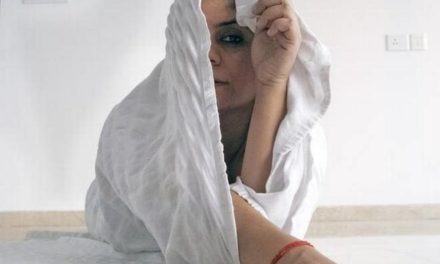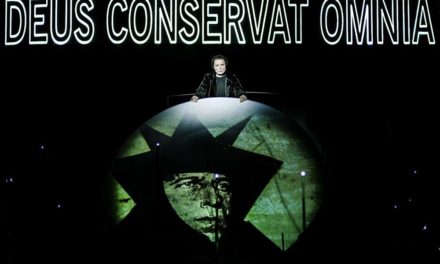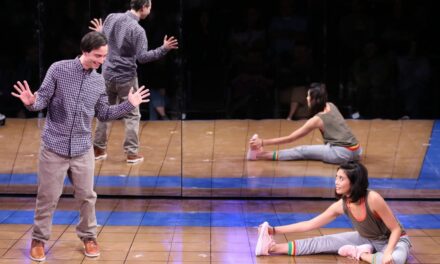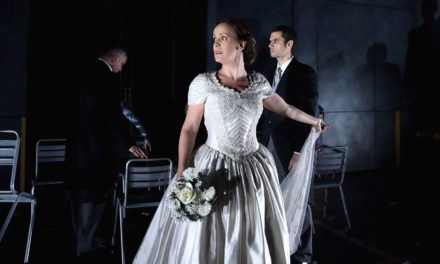Federico García Lorca’s rural trilogy, written in the period between 1932 and 1936 as social unrest increasing polarised Spain, canonised him as a dramatist outside his native country. But these three plays—Blood Wedding, Yerma and The House of Bernarda Alba—merging the symbolic, the lyrical, and the realistic often pose significant challenges both to the translator and director in their striking shifts of dramatic register. Blood Wedding, the first of this trio of plays creates a modern Greek tragedy from the 1928 newspaper story of a pair of cousins—here the Bride and Leonardo—eloping on the eve of the bride-to-be’s wedding. First staged in Madrid in 1933, it is a play where the lean storyline and economical writing avoid easy exposition, allowing the narrative’s ambiguities to remain up to the play’s tragic end.
Marina Carr’s version opts for something more strident, an in-yer-face approach where the play’s mysteries are teased out with a healthy dose of humour, doom-laden tribalism, and allusions to Lorca’s broader life and work. His poetic tale of star-crossed lovers is here refashioned as a tale of domestic abuse, closer to Synge’s Riders to the Sea than Aeschylus’ The Oresteia. Yaël Farber’s production reinforces this line, dispensing with the Andalusian iconography—fans, mantillas and bleached décor that references the white-washed houses of southern Spain. Susan Hilferty’s open, bullring-like design provides a colder, more dour landscape of worn wooden floors and austere furniture, a mythical space where the presence of southern Spain lingers predominantly in the flamenco rhythms of Isabel Waller-Bridge’s rich score merging percussive and woodwind with lyrical strings of Bach’s Matthew Passion. Carr’s adaptation— and this is very much a version rather than a translation—relocates the play to a rural Ireland where the influence of what Carr refers to in the programme as “the long arms of the Church” hovers over the community: a giant iron cross hangs down like an ominous cloud over the house where the Bridegroom-to-be lives with his Mother. The opening image of a bench, table and chairs tossed together like a pile of firewood is accompanied by a distant rumbling sound suggesting a world about to be turned upside down. There is something rotten in this bucolic kingdom. A pool of blood on the floor points to carnage. The Mother may wipe up the stain but by the play’s end, blood has been spilt once more.
Carr’s rewrites give greater prominence to the backstory of the warring conflict between the Mother’s family and that of Leonardo’s Felix clan while ensuring the characters remain defined by the roles they play in the narrative—Mother, Groom, Bride, Father (of the Bride), Housekeeper. Leonardo remains the only character with a name but even this is figurative—león (lion in Spanish) ardo (from the verb to burn arder). This burning lion has a sweeping mane of hair and a tormented, restless arrogance. In Gavin Drea’s characterisation, he appears a genuinely menacing presence, storming on stage without a kind word for either his Wife or the Bride. Farber’s production does not present David Walmsely’s Groom as a more attractive alternative; he too gropes at Aoife Duffin’s sullen Bride, seeing her as a chattel that he inherits from her Father (Steffan Rhodri), a man keen to ensure any marriage is a rewarding economic transaction. Misogyny reigns in this isolated world and it is perpetuated as much by the ever-vigilant Mother and Housekeeper as it is by the men of the play.
Blood Wedding’s feuds and vendettas (unexplained by Lorca) are here linked by Carr to the rape of Leonardo’s sister by the Groom’s elder brother. Vengeance has begotten vengeance as Leonardo’s family has murdered the Groom’s elder brother. The Bride’s mother, viewed as a woman “too busy with all the other husbands” to tend to her own, was likely killed by her own husband and lies under the floorboards of his house. Carr’s version brings domestic violence to the fore—the production opened only a few days after a “feminist emergency” was declared in Spain in a year where 42 women have been murdered by their partners and high visibility rape cases have asked profound questions of Spain’s machista culture. “You’re mine or you’re no-one’s” Leonardo spits at the Bride, it’s both a warning and a threat and one that echoes across a production where women exist to be servile mothers and loyal unquestioning wives.
Death is never far from the surface of Farber’s production. The almost circular stage reinforces the play’s cyclical structure. “The time of blood is coming, it was never really gone,” the Mother pronounces, and this is reinforced in the presence of the supernatural elements—the Moon and the Woodcutters—from the production’s very opening. The former watches over the action in a white suit that functions as a nod to the cream suit in which Lorca was often photographed in the grainy black and white images that remain of the writer assassinated on nationalist orders at the beginning of the Civil War. In Thalissa Teixeira’s characterisation, she observes the action like a contemporary chorus, offering a musical commentary on the events—either through her acapella rendition of songs from the play, as with the lullaby of the horse that won’t drink or through her appropriation of verses from celebrated Lorca poems as with “The Sleepwalking Ballad” and “The Fable and Round of the Three Friends”, works that point both to lost loves and death’s portentous presence. Teixeira’s Moon shifts the furniture as if setting the scene for the events to come; she’s a disarming apparition, an ever-present reminder of Lorca’s early death and the ghostly elements that hover over the play’s pseudo-realist façade. Lorca’s Woodcutters (Faaiz Mbelizi and Roger Jean Nsengiyumva) are here too, floating across the stage in a synchronised fashion, silent figures, axes in hand, early on in the play and then commenting more directly on the action through their verbal pronouncements as they pursue the fugitive lovers in Act Three. Like the Moon, they appear to come from another universe—their attire, moves, words and intonation signalling an otherworldly presence. Farber’s stage world is that of a living cemetery haunted by the dead.
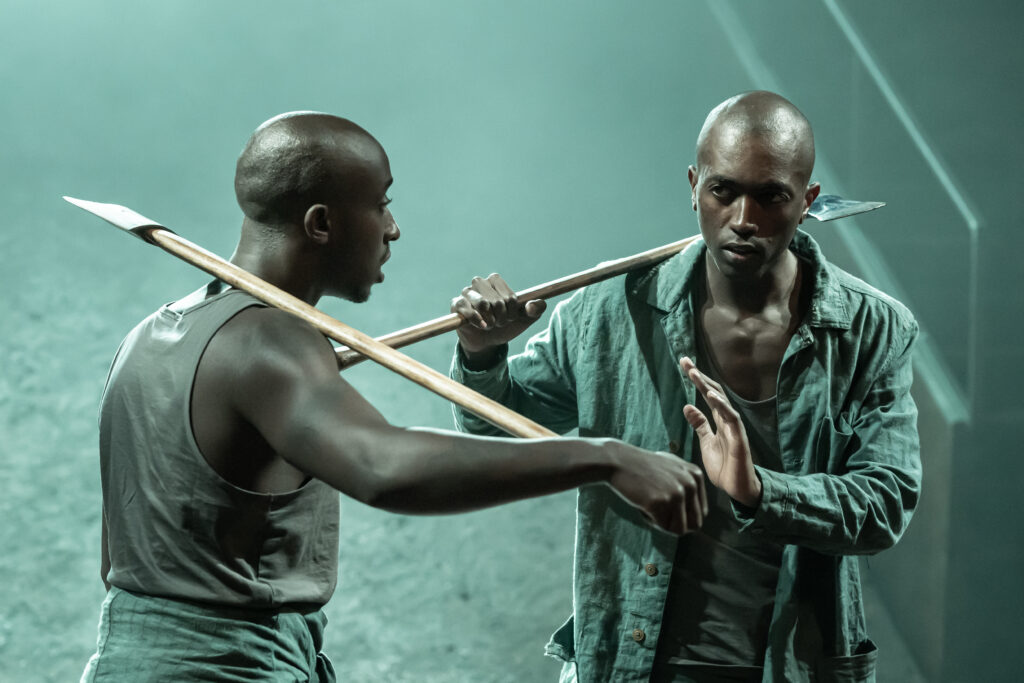
Roger Jean Nsengiyumva and Faaiz Mbelizi as the Woodcutters in Blood Wedding. Photo: Marc Brenner.
Carr’s approach has involved condensing and erasing characters. Leonardo’s Mother-in-Law—who reminds his Wife of Leonardo’s errant nature—has been cut. Brid Brennan takes on the role of a Weaver—combining the characters of the Mother’s Neighbour, the Beggarwoman and the Three Girls (the three fates who handle the strings of life). She is positioned as a figure of bloodshed: a red scarf as the Neighbour; a red woollen belt that spills out over her woollen shirt as the weaver with her spinning wheel reflecting on the dead men; a conspiratorial presence among the Woodcutters as the Beggarwoman craving the spilling of blood. There’s a lovely edge to the writing with Carr’s Hibernian English providing a lyrical lilt that delivers some of the piece’s most striking lines; “she should be on a postcard” the Weaver says of the Bride. The frail Housekeeper refers to herself as “two legs stuck in a jug” and there is humour aplenty in the curt dialogue between the Mother and Bride.
Farber stages the poetry with economy: Leonardo swinging around the circular stage on an aerial rope as if charging through the barren landscape on his horse; Thalissa Teixera’s Moon creating Leonardo’s baby from a long white cloth (alluding both to the wedding dress and the shroud that will eventually cover the dead combatants); the Moon rising up on a harness to illuminate the forest littered with green leaves where the lovers hide: the white of the Bride’s buttoned-up wedding dress rubbing against the black of Leonardo’s taut body as their bodies intertwine.
There is much here that offers a fresh reading of the play. Aoife Duffin’s pouting Bride is opinionated, ironic and feisty. She refuses to perform the role of submissive fiancée when the Mother and Groom come calling with engagement gifts and defiantly refuses to replace her mother’s gold necklace with the rosary she has been given by her mother-in-law-to-be. Her green dress identifies her with the dynamic Adela of The House of Bernarda Alba and while she lusts after Leonardo she refuses to accept that death is the only fate that awaits them, arguing for a new life that they can both forge for themselves away from these sterile lands. Gavin Drea’s Leonardo may attempt to position himself as an outsider but his tousled mane of hair and rough manner links him firmly to the Mother and her inflexible values. His posture of outstretched arms in the form of a crucifix point to the future that awaits him; “I’m the real groom here,” he shouts on the day of the wedding, betraying a frightening sense of entitlement. Annie Firbank’s Housekeeper has some of the play’s best lines. Described by the Bride as “an old vinegary virgin” she’s a warm, wizened presence, representing a softer if ultimately no less coercive, femininity to that represented by Olwen Fouéré’s resolute, uncompromising Mother.
Indeed, Fouéré provides the evening’s standout performance. Her Mother is an avenging Clytemnestra who stalks the stage like a restless wolf, her mane of long, white hair illuminating the stage like a beacon. Tied back for a meeting with her future daughter in law, as if she is holding in her wrath, it is let loose for both the play’s opening and final scenes. A plain-talking woman, she inhales deeply on the cigarette she takes from her son, and smokes a pipe with her neighbour—the fragrant smoke lingering in the air of the auditorium—as she obsesses over the dead. Her deep, rasping voice cuts through the silence like a knife, upholding a system where women remain locked indoors forever destined to mourn the men they have nurtured and loved. It’s a terrifying performance and one that anchors a production that occasionally threatens to veer off course in the business of what’s presented on stage.
This business manifests itself in the references from other works slotted into the action, as well as references Carr inserts to Spain having usurped the Arabs, Jews and Romany whose legacy Lorca so admired. The decision to present the offstage death of the Groom and Leonardo evidently shifts the tone of the final act. The men’s ritualistic bare-chested knife fight evokes that of Saura’s celebrated 1981 film of Antonio Gadés’s and Alfredo Mañas’ 1974 ballet with moments that also conjure something of Bigas Luna’s recreation of Goya’s “Duel with Cudgels” in his 1992 film, Jamón, Jamon. And while the fight seeks to reinforce the Bride’s point to the Mother that “it wasn’t me Leonardo wanted, it was your son,” the spelling out of action that Lorca envisaged as reported, ultimately diffuses the power of the final act. The ending too—with the Bride killed by those left behind to deal with the consequences of the elopement—while pointing to the play’s echoes of the seventeenth-century honour tragedies of Calderón also diffuses the horrors of the hell that Lorca envisaged for the Bride, caged up in a living tomb for the remainder of her days.
Even if I missed a certain sexual chemistry between the Bride and Leonardo and found the references to the mystical “La Manchita”—a transgressive woman whose fate hovers over the Bride as a reminder of what happens to women that refuse to toe the line—unnecessary, there is still much to admire in the re-imagining of Lorca’s play that Carr and Farber orchestrate. The focus on warring tribes and the dangers of sitting “on the wrong side” speak to our troubled era. “These are evil times,” the Mother pronounces in the play’s final scene. They are, indeed. For those that swooned over the slick surfaces of Simon Stone’s urban-set production of Yerma that placed Billie Piper’s title protagonist in a glass cage, this is a very different proposition. But it is one that similarly shows how relevant Lorca’s vision of the danger of entrenched societal conventions is to our contemporary world.
Blood Wedding runs at the Young Vic until 2 November.
This post was written by the author in their personal capacity.The opinions expressed in this article are the author’s own and do not reflect the view of The Theatre Times, their staff or collaborators.
This post was written by Maria Delgado.
The views expressed here belong to the author and do not necessarily reflect our views and opinions.


